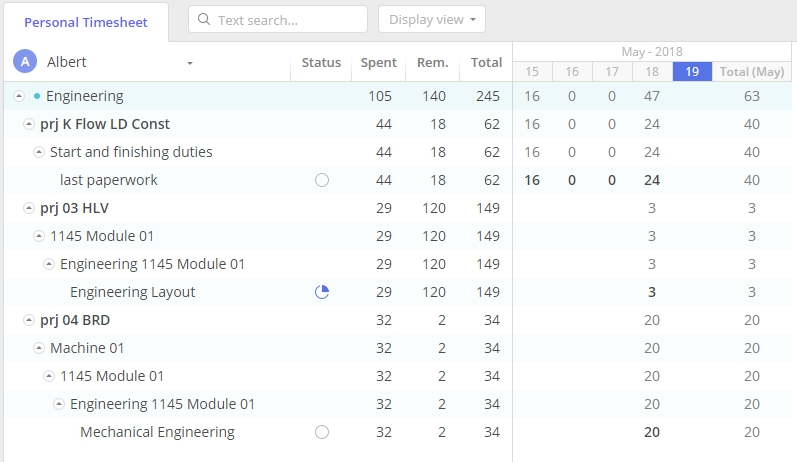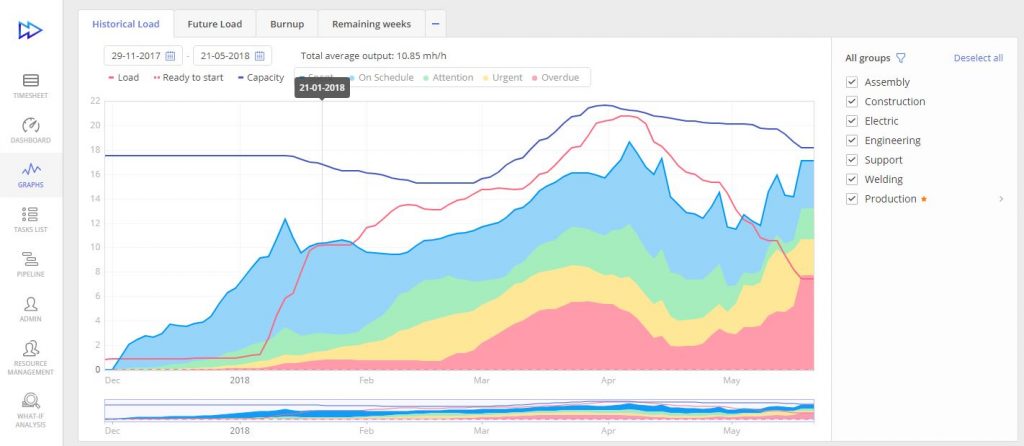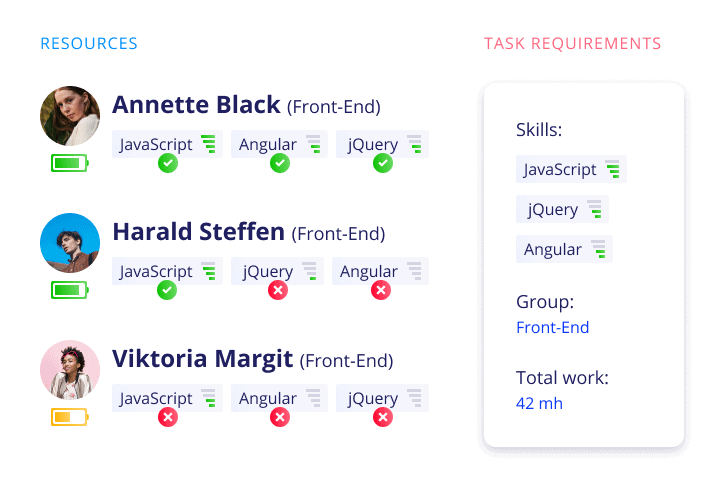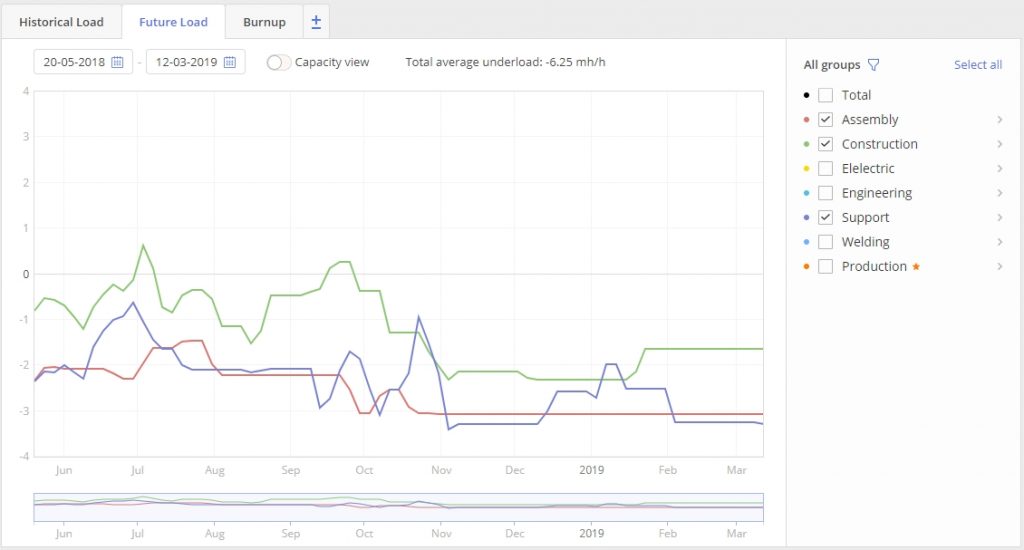Increasing employee productivity is a hot topic in every business environment today. Under conditions of high competitiveness, companies are looking for ways to encourage their people to deliver more.
In a complex multi-project environment with a shared resource pool, there are even more reasons for team members to work as efficiently as possible – otherwise it will be impossible to ensure a seamless and fruitful workflow and successful project delivery.
How to make certain that your team members work at their full capacity, and how a resource management solution can help? Let’s figure it out in the article.
What Affects Employee Productivity?
There are plenty of factors impacting people’s productivity – from proper workflow organization to employees’ lifestyle and health condition. We’ll touch upon those that are in a company’s area of responsibility and can be adjusted by team leaders and/or project and resource managers.
Employees’ workload
There are two unfavorable opposites here. On the one hand, some managers may decide to give people more tasks so that they can deliver more and be more productive. But here comes another side of the coin – team members can become overwhelmed with their tasks and be unproductive instead. Overload is harmful for the workflow – e.g., an overwhelmed employee can make a mistake when being in a hurry to accomplish more tasks, which will create a bottleneck for the whole environment, or do their job at a low quality, which will for sure affect the project results.
On the other hand, employees who don’t work at their full capacity are obviously inefficient. But the problem is that this idleness is rather difficult to detect. Let’s consider the following example. During sprint planning, an employee allotted 40 hours for completing 3 tasks. But in fact, he or she managed to complete them within 30 hours and remained idle for the rest of the time. As a result, such undetected idleness may prevent a company from delivering more orders and increasing profitability. In a multi-project environment, where projects and tasks are interdependent, an idle employee may also become a bottleneck that will hamper the whole workflow.
In one of our recent blog posts, we’ve considered our client’s story who managed to reveal a similar problem (its employees didn’t work at their full capacity), fixed it, and as a result increased their revenue by 10%.
Therefore, to ensure high productivity levels, it’s critically important to keep balance between these two extremes – overload and idleness.
Proper workflow organization
There are three important things to mention here:
- Setting specific and achievable goals.
Efficient work begins with determining precise and at the same time realistic goals. A project and resource manager must have a clear overview of what the team is expected to deliver, and how it will contribute to achieving business objectives. As for project team members, they should be sure of their roles in a project and how each of them contributes to achieving a common goal.
- Determining task priorities.
Productivity in a multi-project environment is impossible without understanding what tasks matter most for the moment. Without that, team members will be trying to complete a little bit of everything, which will actually result in delivering nothing. The only solution for staying productive in such an environment is setting priorities between all tasks across all projects in the environment.
- Matching employees’ skills.
The other important prerequisite for people’s productivity is ensuring that the tasks assigned to them perfectly correspond to their skill level. It also means that critical employees and high performers shouldn’t be given the tasks that less skilled and experienced team members can cope with.
Company culture
We cannot ignore such an important factor. If you want to increase your team members’ productivity, it may be useful to analyze the following aspects of your organization’s culture.
- Communication: How is communication organized between team members and leadership? Do the leaders provide people with constructive feedback regarding their work? Do the employees feel free to communicate any arising issues?
- Collaboration within a team: Do the team members use effective tools that facilitate collaboration between them? Are employees encouraged to share their ideas within a team? Do all the team members fully understand the common goals they work towards?
- Operations: Are the employees provided with everything they need for work (equipment, tools)? Are the tasks distributed fairly between team members? Do they use their time as efficiently as possible?
Analyzing these aspects will make it possible to spot inconsistencies in a company’s culture which can negatively affect team members’ productivity.
Now that you know what you should pay attention to in a company in general and workflow organization in particular, it’s time to explore the ways a resource management software contributes to increasing employee productivity.
5 Steps to Increase Employee Productivity with a Resource Management Solution
An effective resource management solution can address most of the above-mentioned issues and ensure that the project team do their best to complete their tasks. We’re going to show you how it works by the example of Epicflow, a multi-project resource management tool. Apart from ensuring seamless work on multiple projects, it’s also focused on efficient resource utilization which in turn includes maintaining high productivity levels. Let’s explore the steps that will help you achieve this goal and corresponding functions.
Step 1. Monitor employee productivity
Reaching high productivity levels is impossible without tracking team members’ performance. This information is easily accessible in the Epicflow system in several handy formats.
First, Timesheet is a table that gives an insight into the output delivered by the team (or individual team members) over a certain period of time. A project manager can compare the number of hours planned and spent to assess how productive the team has been.

Second, you can use the Historical Load Graph which visualizes detailed information as to the output produced by the team members graphically. It compares completed work with employees’ capacity within a certain timeframe. Also, it presents the output divided into categories indicating the amount of work that has been completed on schedule and with a delay.

Monitoring this data will allow a project/resource manager to assess the fruitfulness of work on a project: whether or not there are any difficulties that have to be addressed to ensure a high level of employee productivity.
Step 2. Set the right priorities
One of the core functionalities of Epicflow that makes it possible to deliver multiple projects successfully and ensure efficient work on numerous tasks is automatic AI-driven prioritization that is carried out with regard to all project-related data. First, it’s a great assistance to every team member – they don’t have to analyze and decide which of the tasks they should work on at the moment. Epicflow analyzes the necessary project data and makes these decisions for them. As a result, every team member has a prioritized to-do list available in the Task List feature.
But that’s not the whole story. It also prioritizes current projects in the pipeline so that a project manager can stay in the know which project needs maximum attention for the moment.
Finally, Epicflow provides a single source of truth regarding project and task priorities for both a project manager and every team member, which contributes to consistent and efficient collaboration and in turn increases productivity.
Step 3. Use a more efficient approach to workflow
As we’ve mentioned earlier, setting deadlines for tasks and adding a buffer to each of them in a multi-project environment have nothing to do with efficiency. In this case, a team member can be trapped by two biggest productivity enemies – student syndrome and Parkinson’s law. In the first case, they will procrastinate and start work on a task as late as possible, just like most of us did when we were students. In the second case, they’ll use all the time allotted for completing the task even if it can be completed faster. Your team members won’t be efficient under these conditions.
Instead, Epicflow offers a different approach. Employees should complete their task as soon as possible and after that proceed to the next assignment immediately. Such an approach creates conditions for more productive work on project tasks and faster delivery.
Step 4. Make sure that team members’ tasks correspond to their skills
To allocate resources properly and make project work as productive as possible, you need the information on each team member’s skills, capacity, and availability. It’s impossible to keep it in mind, especially if we talk about large organizations with hundreds or even thousands of workers. But Epicflow has a solution: it not only stores this data, but also analyzes it and suggests the best resource allocation options possible. At the same time, you are not bound to follow these suggestions without any doubt – Epicflow serves as an advisor, but the final resource allocation decision is always up to you.

Step 5. Detect improper workload
Finally, you can protect yourself from improper workload in the future, namely eliminate both overload and idleness. Epicflow’s Future Load Graph uses real-time data on employees’ involvement into active projects to predict their workload in the future. As we’ve stated earlier, both overloaded and idle employees can’t be productive. So, to ensure subsequent efficient project work, a project/resource manager will have to adjust the workflow to avoid these bottlenecks.

Following these steps will greatly contribute to increasing productivity of your team members.
If you still have any questions or want to learn more about utilizing your resources to the full and ensuring seamless work on multiple concurrent projects, feel free to contact our experts and book a call.
